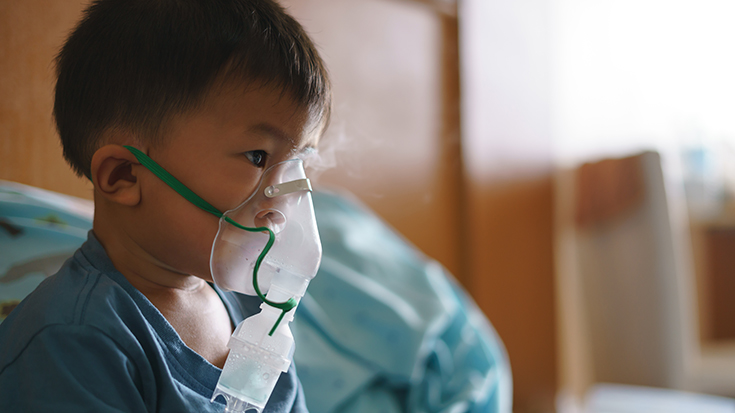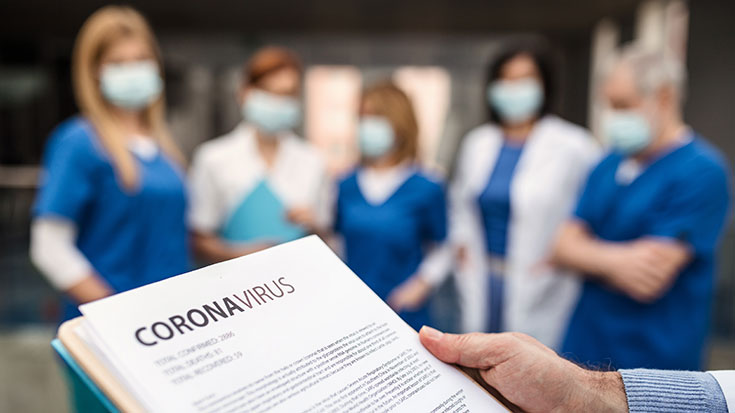
The pandemic has raised many safety issues related to the delivery of patient care. Still, for respiratory therapists, the debate surrounding aerosol-generating procedures (AGPs) has probably been one of the biggest. Nebulization has particularly been called into question. As a result, many hospitals that had previously switched from MDIs to nebulization for in-patients to improve care and save on costs discontinued those programs.
Now with more than a year of pandemic experience under their belts, some hospitals are rethinking that move. Is it safe to use nebulizers in the hospital setting during a global pandemic spread by respiratory means? Three RTs share their experiences.
In, then out, then back in
The Sarah Bush Lincoln Health System in Mattoon, IL, was beginning to explore the switch to nebulization when the pandemic hit.
“Prior to the pandemic, we used common canisters for MDIs and also administered nebulizers,” said Lexie Caraway, MBA, RRT, RRT-NPS, RRT-ACCS, AE-C, manager of respiratory therapy. The common canister program was implemented about eight years ago as a cost-saving measure. The decision to switch to nebulizers came from a multidisciplinary team that reviewed new medications, processes, and options on the market.
COVID-19 put a swift end to those plans.
“In the beginning of the pandemic, we worked with [the] pharmacy to order additional MDIs and transition all medications to non-aerosolizing medications in an effort to protect our staff,” Caraway said.
As the months wore on, however, the general feeling of the RT staff was that MDIs were not delivering enough medication to patients who needed it.
“Many of our regular COPD patients were not relieved of their shortness of breath and did not have the strength and/or coordination to activate the inhalers they were receiving,” she said.
Nebulization was considered a better option for these patients, and the staff went to bat for their patients in advocating for a return to the previously decided-upon policy. By October of last year, the hospital reinstated the nebulization option.
Caraway says she is proud of her staff for stepping up to speak for patients in need, even when others in the hospital were still wary of the change.
“Some physicians and nursing staff voiced their concerns about these aerosol-generating procedures and others such as the use of high flow oxygen. But, ultimately, it was decided that we needed to do what we felt was best for our patients,” she said. “To date, all medications are nebulized at our facility, with a few exceptions, including patients on our behavioral health unit and patients who refuse nebulizers and wish to provide their own home MDI.”
Caraway believes nebulization can be performed safely in hospitals with the proper precautions. In their case, they ensured all staff members had adequate PPE, including N-95s, gowns, and PAPRs. In addition, all nebulizers were breath actuated, and each nebulizer was filtered. Patients received their nebulizer treatments in negative pressure rooms, and additional rooms were added as COVID-19 cases surged in their area.
Staff in and out of respiratory care were well educated on the factors involved as well.
“We provided extensive education with our RT, nursing, physician, and leadership about how we were safely and effectively administering nebulized medications,” Caraway said. “Only a few of our staff have had COVID over the past year. None of the cases were linked to patients who received AGPs under our care.”
Sticking with the status quo
Texas Health Resources Southwest Fort Worth was already delivering respiratory treatments primarily by nebulizers before the pandemic hit.
“Our policy was all patients will receive nebulizer treatments while in the facility unless the patient brings their home MDI and the physician agrees to continue that use of said MDI,” said Matt Nolan, MBA, BSRC, RRT, RRT-NPS, RRT-ACCS, director of cardiopulmonary and neurodiagnostics. “Otherwise, the home med list of MDIs is converted by pharmacy physician-approved protocol to the nebulizer equivalent.”
Part of their rationale for the policy was that if the patient’s MDIs were working as they should, the patient most likely should not have ended up in the hospital with an acute exacerbation. Much of the problem centered around patient misinformation about treating their disease.
For example, RTs had identified patients using multiple rescue inhalers in a row before finally deciding to seek care at the hospital. However, others did not know how to use any of their MDI devices correctly.
“Having patients on nebulizer-only treatments here in the hospital provided the RT department the ability to catch up with the disease process, streamline the care of the patients, assess the ability and education of the patient on MDIs before discharge, as well as work with the physicians and case managers to help send patients home on what is best for the patient,” Nolan said.
The cost savings to the hospital came into play as well, and since patients can now go home on pocket mesh nebulizers for under the price of a co-pay and with enough medication to last for a month, it seemed like a win-win situation.
All of these factors figured into the hospital’s decision to stick with nebulizers despite the pandemic.
That doesn’t mean, however, that they didn’t face some opposition. Early in the pandemic, Nolan says they were approached by many colleagues who had read this or that article on APGs and the risks they may or may not pose. Working closely with their infection prevention physician and IP nursing leadership, they decided proper PPE could keep therapists safe.
As a result, RTs have continued to work off protocols to deliver SVNs to spontaneously breathing patients, MetaNeb treatments to patients with consolidation, and mesh nebulizers to those on BiPAP and ventilators, among others. The only change was that therapists must wear an N-95 and a face shield while in the patient’s room.
Nolan says the hospital was fortunate to have a corporate office and supply chain that kept them fully stocked with all the PPE they needed. He credits the whole team — from RTs, to IP specialists, to RNs, to hospital leadership — for deciding that the nebulizer policy could be safely maintained during the pandemic.
He points to the COVID-19 transmission record in his facility as proof that the plan is sound.
“The most important step in knowing our PPE was working is that for over a year of the pandemic, the RT department has had zero patient-to-staff transmission of COVID-19 where there were no breaks in PPE guidelines,” he said. “That is really the main job of any leader — the safety of all staff.”
Not worth the risk
RTs at White Plains Hospital in White Plains, NY, also had a nebulizer policy firmly in place before COVID-19 came on the scene, delivering about 48,000 of these treatments every year.
Like what happened at Sarah Bush Lincoln, it all came to an end in March of last year. But by September, the hospital was once again ready to reinstate the program. Outcomes, however, were troubling.
“We began to see an uptick in COVID and were seeing small clusters that we felt the aerosols were contributing to,” said Lyn Harper, MPA, BSRT, RRT, AE-C, director of respiratory care. “So, we once again stopped all nebulizers.”
Unless the patient is in a private room and there is a clear indication for the nebulizer over the MDI — for example, the patient cannot effectively use an MDI — patients will receive an MDI.
The key rationale for the decision was a reduction of APGs in the facility. However, given the uptick in cases they have seen in relation to nebulizer treatment, she says they have no plans to go back to their pre-pandemic ways any time soon.
“Our experience with clusters throughout the hospital due to aerosol-generating procedures has led us to the point of a reduction of nebulizers to a very large degree,” she said. “At this point, it is not our intention to change our policy in the near future.”
The debate will continue
The debate over whether or not nebulizers are safe during an outbreak of disease driven by respiratory aerosols will likely continue for some time to come. However, as the key clinicians delivering these treatments, respiratory therapists can and should help guide the way for their facilities.
Lexie Caraway, Matt Nolan, and Lyn Harper have all done just that in their organizations. While they haven’t all reached the same conclusions, their thoughtful approach to the problem can serve as an example to other therapists dealing with this issue.
Email newsroom@aarc.org with questions or comments, we’d love to hear from you.














